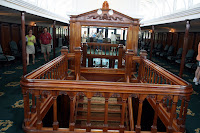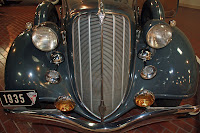The Majesty of Old Quebec City
 City and drove to the
City and drove to the  ferry parking lot early the next morning. We enjoyed a short, pleasant cruise and were captivated by the fabulous city skyline with the famous Chateau Frontenac serving as the centerpiece. Our traveling companions, Lloyd and Elaine, had been here on the 50th WBCCI Anniversary Caravan, but this was our first time to taste the elegance of this historic place. Sure of its
ferry parking lot early the next morning. We enjoyed a short, pleasant cruise and were captivated by the fabulous city skyline with the famous Chateau Frontenac serving as the centerpiece. Our traveling companions, Lloyd and Elaine, had been here on the 50th WBCCI Anniversary Caravan, but this was our first time to taste the elegance of this historic place. Sure of its  charms, Quebec City’s gracious yet simple, romantic style continues to delig
charms, Quebec City’s gracious yet simple, romantic style continues to delig ht visitors. Some refer to it as the most beautiful city in North America. The city rests in an enchanting setting on the St. Lawrence and has a priceless architectural heritage, a rich and colorf
ht visitors. Some refer to it as the most beautiful city in North America. The city rests in an enchanting setting on the St. Lawrence and has a priceless architectural heritage, a rich and colorf ul past, and above all, a warm bubbling heart that has characterized it for four centuries.It was in this old fortress city, dubbed the “Gibraltar of America” by Charles Dickens, that Samuel de Champlain first established a fur-trading post in 1608. As religious and political institutions sprang up within the fortifications, merchants and craftsmen set up shop alongside the river. A coveted prize that was subject to repeated assault, Quebec City eventually fell to the British in 1759, and New France became a subject of the English crown.Quebec City (pop. 622,000), the cradle of French civilization in North America, is today a busy seaport, research center, and a cultural hot spot. The astounding architecture and colorful surroundings make this one of the most unique cities in the world.
ul past, and above all, a warm bubbling heart that has characterized it for four centuries.It was in this old fortress city, dubbed the “Gibraltar of America” by Charles Dickens, that Samuel de Champlain first established a fur-trading post in 1608. As religious and political institutions sprang up within the fortifications, merchants and craftsmen set up shop alongside the river. A coveted prize that was subject to repeated assault, Quebec City eventually fell to the British in 1759, and New France became a subject of the English crown.Quebec City (pop. 622,000), the cradle of French civilization in North America, is today a busy seaport, research center, and a cultural hot spot. The astounding architecture and colorful surroundings make this one of the most unique cities in the world. ens and close proximity to the great outdoors add to a superb quality of life here. From the top of its imposing ramparts down to the mighty
ens and close proximity to the great outdoors add to a superb quality of life here. From the top of its imposing ramparts down to the mighty  St. Lawrence, Quebec City, the only fortified city north of Mexico, offers a plunge into a colorful pageant of history. The huge, old, black cannons are in mint condition. If you are a dedicated shopper, you can trek up and down the scenic, rolling, cobblestone streets, as we did, and have your choice of wall-to-wall upscale gift and clothing stores. Along the way, is a multitude of
St. Lawrence, Quebec City, the only fortified city north of Mexico, offers a plunge into a colorful pageant of history. The huge, old, black cannons are in mint condition. If you are a dedicated shopper, you can trek up and down the scenic, rolling, cobblestone streets, as we did, and have your choice of wall-to-wall upscale gift and clothing stores. Along the way, is a multitude of  restaurants, bakeries, and snack shops. We were surprised at the friendliness of the people. Of
restaurants, bakeries, and snack shops. We were surprised at the friendliness of the people. Of  course, French is the language spoken, but shop employees are mostly bilingual. Sidewalk musicians are plentiful, and in the park squares there are talented entertertainers galore. Most of them are quite professional. While tips are appreciated, they are not rudely demanded.
course, French is the language spoken, but shop employees are mostly bilingual. Sidewalk musicians are plentiful, and in the park squares there are talented entertertainers galore. Most of them are quite professional. While tips are appreciated, they are not rudely demanded.We were rather fascinated by a wedding taking place in a downto
 wn cathedral. We first spotted the bride with her father on a buggy ride. Later, as she and her groom were exiting the church and climbing into the horse-drawn carriage, we were a part of a lar
wn cathedral. We first spotted the bride with her father on a buggy ride. Later, as she and her groom were exiting the church and climbing into the horse-drawn carriage, we were a part of a lar ge crowd of well wishers.
ge crowd of well wishers.At the end of the day we were exhausted from our touring adventures and eagerly retuned across the river to our campsite. We wonder why so many people fly thousands of miles to tour other continents and abstain from visiting Old Quebec City in close-by Canada. It took us a long time to get here, but now this majestic city has its place as one of our most cherished memories.











































